The Sony Ericsson K750i is undoubtedly the most highly anticipated model of 2005 for the majority of mobile phone users. This waiting was caused by many things, but mainly because of information about the phone appeared much earlier then the phone was officially announced. We mentioned the phone in December of 2004 for the first time, and the functionality of the phone was clear then. Keeping the functionality in mind, we thought it would be classified as a T650. The latest reorganization of the product line saw the T-series removed, and the manufacturer decided to renew the indexes. In 2003, the leader of SE's line was the T610, which was a bestseller and is still sold in some places. A new device was later introduced with a few improvements in a similar style to the T68 and T68i. Keep in mind these facts for the end of the review.

The new leader of the company, the K750i, had the name of Clara inside the company. Similar to previous leading models, the emphasis is put on the most demanded and actively promoted functions in the market; for 2005, this means a quality camera and Mp3 player, all other functions were also changed in accordance to the device itself. As for the previous models, the device inherited all of their strengths and the hardware became more powerful, which is necessary for properly working and storing pictures from the 2-mega-pixel camera. The processor operating speed and its power grew, which is why there were many software problems in the development of the K750i. The main challenge for engineers was not the functionality of the phone, but forming a specific set of characteristics to fit in a body comparable to the previous phones. The company decided that the user should see not only the inheritance of features, but in design as well. Why should they accustom users to a smaller size if the next device in this class will have larger dimensions? That is not only illogical, but it also pushes the audience away. The company's lack of resources has made developing modern devices in a short time next to impossible.
The phone itself will be presented in 2 colors, which is very interesting. The operators will be offered models in more colors, but with different indexes; for example, the K750 copy for T-Mobile is the D750.




The dimensions of the K750 are quite comfortable (100x46x19.5 mm, 99 grams) but unusual for a phone with these functions. The device belongs to the group of models with double-side orientation, a phone on the one side and a camera on the other. The integration of a phone interface and a digital camera allows users no need to put extra effort in learning how the camera works, since everything is similar to usual cameras. Looking at the front panel you see the standard layout of keys and functions. The first unusual thing is that the loudspeaker gaps are placed very high on the phone, almost on the top edge. This is caused by the small size, since the dimensions haven't changed but the filling has. This position hasn't hampered the loudspeaker work in anyway, the speaker is heard well, and the position means nothing. The decrease of the loudspeaker power may be considered a negative factor; we managed to get the same sound, volume of call, melody reproduction and mp3 player as on the models of the current line. Energy consumption of the loudspeaker is much lower, and that is an evident plus.

The screen has undergone no changes and is the same as previous models, such as the K700 and K600. It has the same resolution of 176x220 pixels (28x36 mm) showing up to 262K (TFT) colors. Physically, its matrix has no differences from the previous models, and using another controller causes the increased number of shown colors. You won't see any principal difference between 65K and 262K colors in the screen, the picture is good, vivid and the interface drawing is very pleasant. The display gives way to Samsung and Sharp models in the picture brightness, but in general belongs to its own group rather than to the middle-class. No problems appear in the screen, and moreover, it is obviously one of the best in this form-factor. The picture fades in the sun, but text remains readable. To tell the truth, small font-size prevents from seeing all the necessary details sometimes but this doesn't concern SMS and names in a phonebook, here everything is all right.

The keypad is made of plastic and number keys are placed in a single block. Working with the keypad is of normal comfort and that is seen as a compromise. One can't call the keys uncomfortable but they don't represent the best variant. The majority will find the keypad acceptable and nothing more. The backlighting is white and well seen in various conditions.

The joystick is unusual in the model. It is made in the style of the "soft touch" technology, when the slightest deviation allows controlling movement along the screen. It doesn't look comfortable at first sight, accidental reactions are frequent, and a feeling arouses it lacks some harshness. With time you get so accustomed to the joystick that on the other phones they seem too tough and hard to control. Many people found it very comfortable having acquainted themselves with the K750.

An innovation of the model, an Activity Menu button, is above the joystick in the middle. In some ways we see a combination of interface changes and its hardware support. There are three bookmarks in the Activity Menu; on one you can add personal tags relating to frequently used functions and the third bookmark serves for specifying links to various resources. The main bookmark, shown by default, is last events list; they may be missed calls or calendar events. That is in some kind a copy of an event list in the latest models by Siemens. This is the main interface difference of the model from other phones by the company. It should be considered as a prototype of future phones' functionality, that will mainly be applied to the K750i based models.

There is an IrDA gap on the top end of the phone, and a turn
On/Off button is also here. A new interface slot Fast Port is
placed on the bottom end. The necessity of changing the interface
is caused by the growth of data transmission speed. The company
takes such steps very rarely and they look well-taken. Also it
leads to the total change of all the accessories starting with
the chargers and ending with cables. Unfortunately, there is no
standard earphones output, and connection may be established only
via Fast Port. Considering the peculiarity of the phone construction,
the phone adds only about half of centimeter, the same is right
for Nokia phones.




If a strict limitation was put on the phone size, the company took another solution for accessories. A USB cable provided in the kit is long and that is a minus for those who will use it in several places. The majority of today's PCs have front USB outputs, thus there is no need for a long cable. The same can be said for notebooks and other portable gadgets. The company originally planned to deliver a short cable, which would have been ideal for transporting from one place to another. Another minus are the opened pins in the phone connector, there is a possibility to damage them when carrying it in a bag without a special cover, and thus it seems not to be much of a mobile solution.
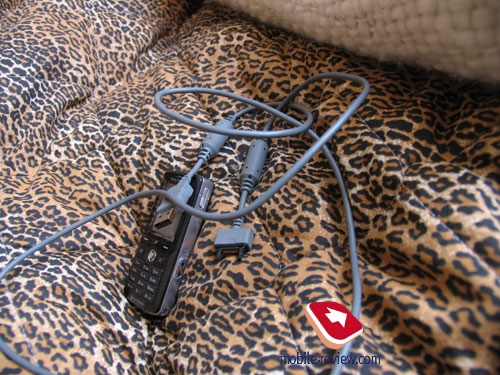
Unfortunately, the hot USB connection is not ideal and greatly differs from the one in the Motorola E398. Installing drivers is always necessary; otherwise the device won't be identified. Also, we should mention, only memory card data is acceptable, access to the user data is denied. That is not a serious minus, since the same data is kept on the card and all the applications, photos, images are saved there by default. This allows keeping the device on when using a USB connection, which allows the device to serve as an external drive based on MS Duo cards in some way.
A memory card slot is on the left-side surface closed with a shutter. In difference to smartphones, a rubber shutter was not applied here, and that is a conscious construction simplification. The shutter is tough and needs pressing to be fixed. If treated wrong, it may be pulled out.


Up to 4 GB of memory is supported and cards up to 2 GB are announced. A 64 MB memory card is included in the kit, and that is a necessary minimum to add to the internal memory. The user has about 30 MB of free space at his disposal at first, which is enough for almost all the operations, and considering the device sees no difference between the card and the internal memory, no need for extra capacity appears. There is a button responsible for accessing the last musical function on the left side; it may be radio or mp3 player. You may activate playing from the play list or radio with one press. The solution is comfortable, considering the functions work in a background mode, the idea is the best and there are no copies in this parameter.
There is a coupled volume level button on the right surface designed like a swing. The button is small which prevents controlling the volume comfortably without concentrating on the button. The button is mostly used in photo mode; it is not frequently used for the phone functions (slam size and right-side disposition). The button (pressing and holding it) also activates voice dialing.
A flash and an active shutter covering the camera lens can be seen on the back panel. Opening the shutter activates the camera, now you can hold the phone horizontally and take photos.
The battery compartment has also undergone some changes caused by the necessity to make more room. A folding cover brings no potential problems and the construction is reliable. Naturally, there are users that will drop the phone on the floor without closing the cover and break it as a result. Using the phone normally you will have no problems with it.



There is a 900 mAh Li-Pon battery. According to the manufacturer,
it is capable of working for up to 400 hours in the standby mode
and up to 9 hours of talks. In Moscow the device averagely worked
for about 3 days in case of one hour of talks, up to 45 minutes
of using other functions and two hours' listening to the radio
a day. If working less with the phone, it will work about 4 days.
Full recharging takes about 2 hours. Using the device as an mp3
player brings no serious battery life shortage, the model works
for about the same time period (energy consumption is comparable
to the radio mode).
Menu
As for the menu organization, it is typical Sony Ericsson style with only Activity Menu added. You may assign tags or speed dialing of this or that function to the joystick deviations. The main menu is represented with four rows with three icons in each. You may also use fast navigation with the number series, and then switching to a needed item will only take a few seconds.

The input convenience remained on the same level, by pressing
the # key you will bring up available language list, and be able
to switch between them while text input.
The manufacturer decided to take care of additional horizontal
theme bookmarks. This means that now when you are in the call
list menu, which is called by pressing the Call button, you will
see not only the last dialed numbers but gain the ability to switch
between bookmarks with last missed/received calls (horizontal
joystick presses). In the phone's menu such navigation is used
in all possible places, it strongly simplifies usage of phone;
menu's ergonomics in this model is extremely high. I'd like to
point out those similar horizontal panels present in the phone
book, settings menu and several other menu items as well.

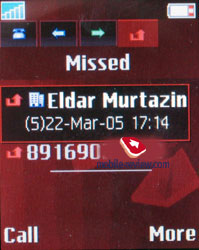
The model is mainly a copy of the K700 with different menu representation,
new themes, more phone book entries possible, but the base is
the same. The next serious interface renewal is intended for the
end of 2005, and for the mass products it will be summer 2006.
Phone book. As different to the previous models
up to 500 names with all the fields filled in are supported (alike
the K600, Z800). Summing up, we get more than 2000 numbers that
are more than enough for the majority of users. And a poll carried
out on our site proves the same.
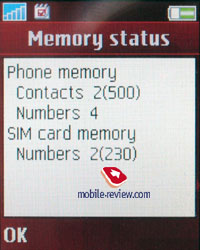
Several phone numbers, e-mail address and other contact information
may be kept for a name in the internal memory. In settings you
can choose the required fields, as well as sorting by various
fields including name, surname, but the input field remains single.
Such sorting is important only while transferring data from PC,
for phone's entries it's actually useless. For separate names
you can setup custom ring tones and own picture, while the incoming
call you will hear the custom ring tone, as well as chosen image.
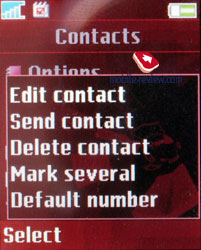
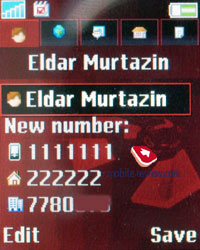
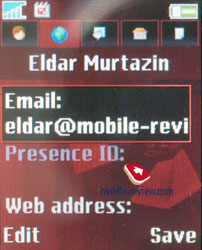
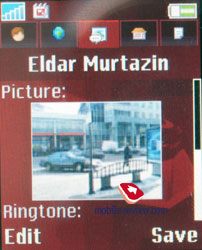
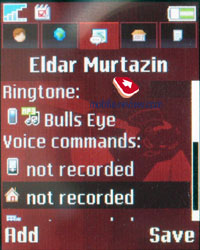
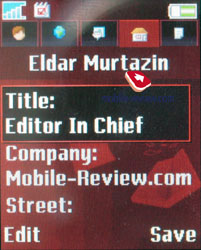
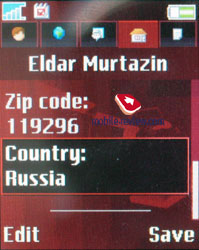
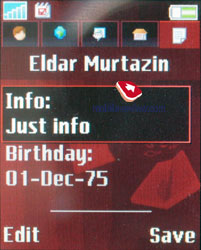
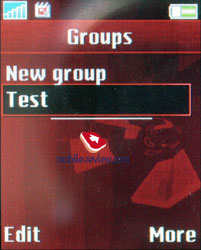
While information input you are free to scroll between bookmarks,
on the first one phone number entering and their sorting according
to types. Actually this organization reminds Outlook for some
reason, it is convenient. Ability to add voice dialing to separate
numbers stored under one name was introduced as well, there can
be up to 40 of them in total. If you remember, earlier on voice
dialing was supported only for names, and you had to make additional
voice dialing bookmarks for other phones stored under the same
contact.
While viewing the phone book you can scroll the numbers by the
horizontal joystick's keypress, as well as watching other information.
Of course the default number will be bind by you.
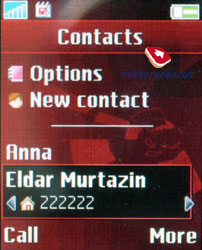
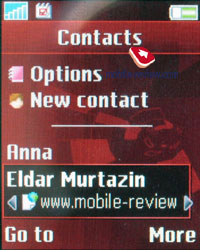
Traditionally the company believes that SIM-card and its memory
will be used only in emergency situations, and not for storing
information continuously. Viewing the entries on the SIM-card
is possible from the separate menu item; they are not displayed
in the common entry list.
Messages. All functions are basic for messages;
templates and ability to create your own ones are present. For
messages storing phone's memory as well as SIM-card's is used.
Chat function is supported, on the whole I can say that the features
are pretty common for any other phone.
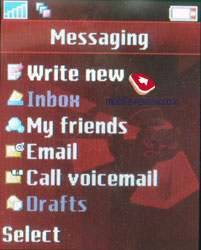

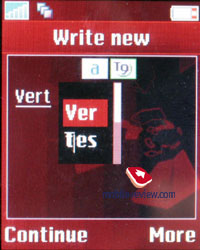
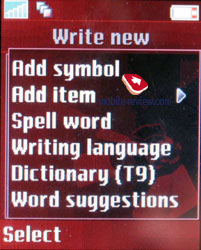
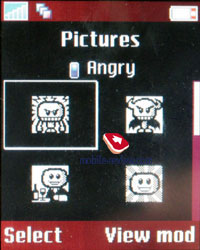
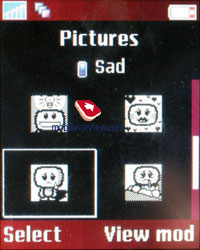
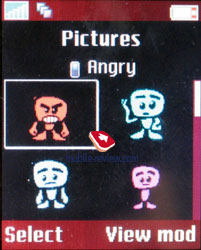
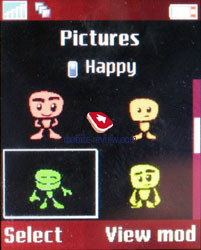
MMS realization deserves to be mentioned as well, you can actually
create clips, there are a lot of settings and it is not hard to
use them, a truly unique quality that other phones lack.

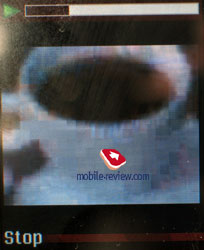

E-Mail client supports sending and receiving messages, all possible
encodings are supported.
In this menu Instant Messaging is present as well, sort of ICQ
analogue.
Call list. In common list you will see up to
30 entries with date and time assigned to each. Near each of them
an icon will explain to what type of call it refers (missed, received,
dialed). Besides this in common list additional icons are present,
they show if the phone number is present in the phone's memory,
or SIM-card's. The list of missed calls can be viewed separately,
it can store up to 10 entries. In the same menu item information
about cost and length of last, all calls can be viewed. Moving
through the separate lists can be made with the help of bookmarks,
this actually saves your time greatly.


Entertainment. This menu item contains access
to picture album, list of music files. Function MuiscDJ is interesting,
although it is rather niche and will not be in demand around most
of users. In this editor you can create your own ring tones and
edit up to 4 tracks.
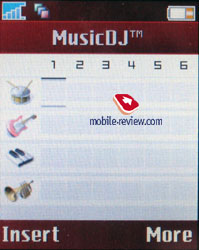
VideoDJ is an advances version of a MusicDJ function. It allows
editing not just music, but adding pictures, notes and the result
is a 3GP file possible to send via MMS or E-mail or just sent
to another phone.
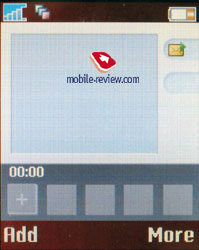
A graphical editor for drawing simple pictures is for creative
people. Sometimes it helps to while away the time, though mainly
the function is unnecessary.
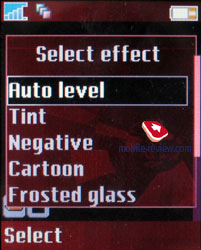
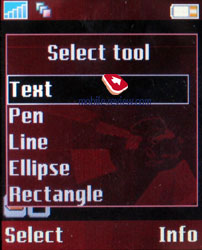
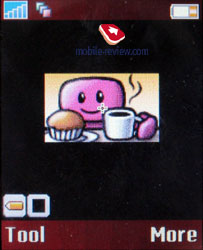
Organizer. In organizer menu a lot of functions
are stored at once, first of all - let's review the calendar.
There are three types of event view, monthly, weekly and daily.
In last case you see the list of all things to do and reminders,
in two other modes you will notice the highlighted time with events
or the day. Fast transfer to the required year, day and month
is present. Everything is pretty simple and traditional, as well
as schedule entry. Basically you get the chance to choose one
of the 6 icons assigned to the action type, specify the place
where it will occur, length and setup reminder (beforehand or
in the entered time). I was unable find a way to setup reoccurrence
rate; in my samples this feature was not present at all. From
the editing menu for separate events you can choose another time
and date, and that's it. Reminders work even if the phone is turned
off, in case you turn on this function in the settings menu. Pleasant
peculiarity of this model is that you can turn on/off automatic
switch of profiles after the event had occurred, as well as return
to the earlier set profile after the event is over. Basically
we get analogue of Time Profile function in Nokia's phones.
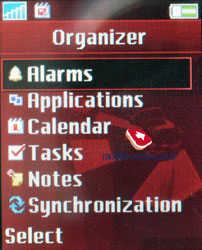
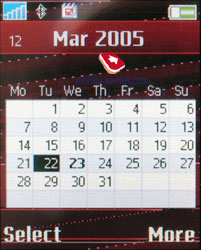
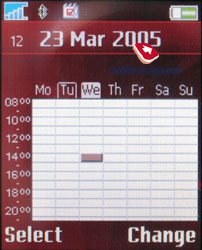
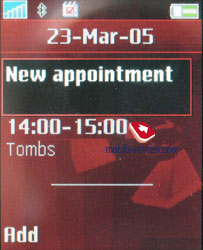
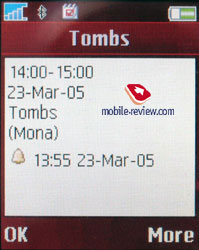
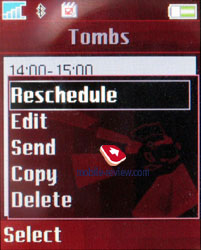
To do list of rather ascetic, only two modes of events, call
or reminder. On the other hand this is pretty enough, simplicity
has its own advantages as well.
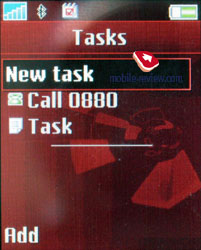
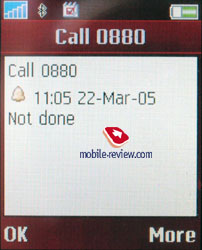
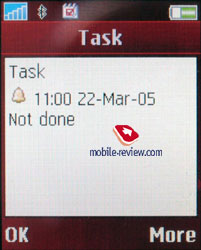
The phone has fully-functional search, which is organized for
calendar, you just enter the words (or part of it) and after few
seconds see all events which suit for the searched words. Function
works very fast even if there are more than 100 entries, fast
teleportation to the event is supported as well.

The phone has normal support of sending schedules to different
devices (like always - IrDA, Bluetooth). You just choose the required
interval (day, week, or month) and send all entries. I'd like
to point out the fact that receiving device must support PIM function
in order to receive and display these data files correctly. When
we tried to send our own schedule to TV-set it was successful,
although it could not be displayed (via IrDA). Same thing can
be sent from your office or desktop PC without any additional
software for synchronization.
Notes. The phone supports recording short text notes; in common
list first word from each is displayed. This is not always convenient
since you have to enter every note with "marker word",
in order to remember what it is all about.
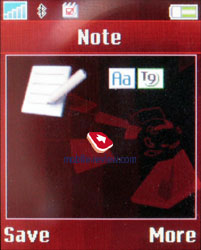
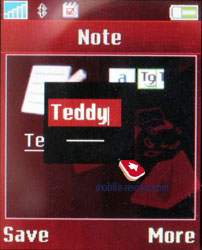
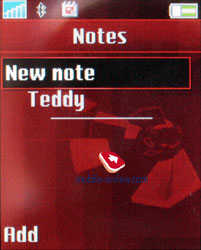
Alarm clocks. The phone has single as well as reoccurring alarm
clock, which can be setup by the defined days of week. The alarm
clocks will work even if the phone is turned off.
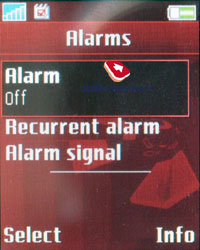
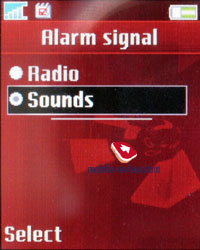

Countdown timer. Everything is pretty simple here, although same
thing can be said about the stop-watch, it supports intervals.
The phone has code storage, which was loved by many, working with
calculator became more convenient.
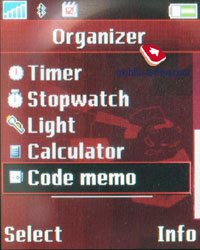
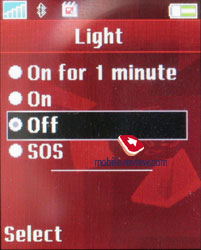
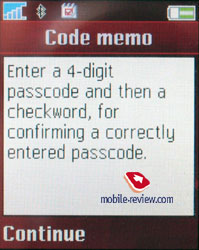
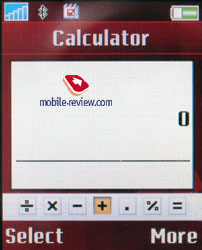
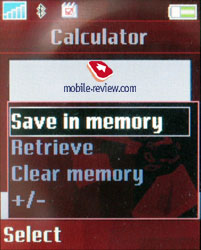


Also a world time function are present.
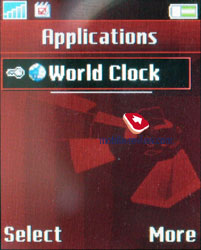
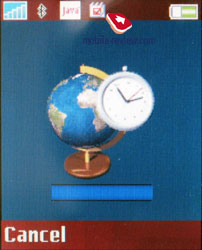
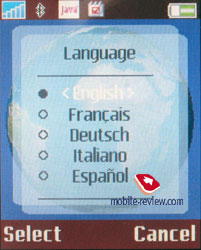

Connectivity. From here you can setup all communication
settings of the phone starting with WAP, GPRS, bluetooth and ending
with synchronization. The standard usage will not be mentioned,
it is pretty obvious, everything works. I'd like to stress that
no problems were encountered while synchronizing; synchronization
with devices runs smoothly, all profiles are supported.
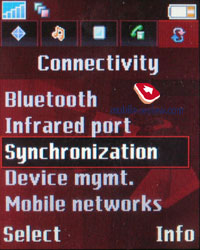

The same menu provides local and remote localization settings,
everything is also standard. The device supports the HID profile
that allows using it as a remote controller for a computer or
other device.
The following Bluetooth profiles are supported:
- Dial-up networking profile
- Generic Access profile
- Generic Object Exchange Profile
- Object Push Profile
- Serial Port Profile
- Handsfree Profile
- Headset Profile
- Synchronization Profile
- Basic Imaging Profile
- File Transfer Profile
- HID Profile
- SyncML OBEX binding
- JSR-82 Java API
WAP. The browser was given separate menu item's
sport, its version is 2.0 and it supports secured transfers, which
is important for electronic transactions. With the help of browser
you can download new wallpapers, themes, ring tones, everything
is available on the original web-site.
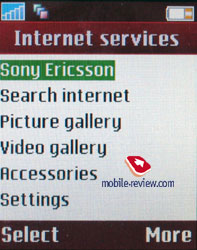
Settings. Basically all settings related to
the work with the phone are stored here, partly with the appearance
of screens. I will not describe this menu item, since everything
is too common. The presence of updated themes should be mentioned
though, they actually differ the appearance nicely.
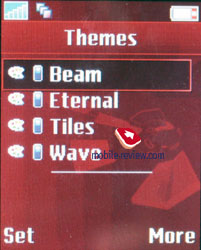
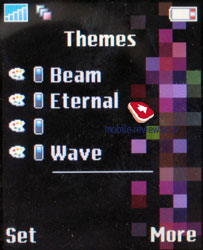
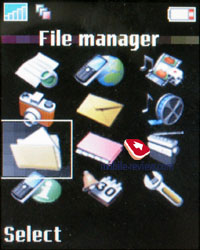
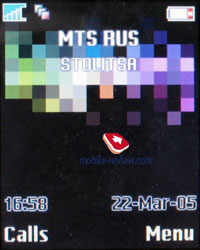
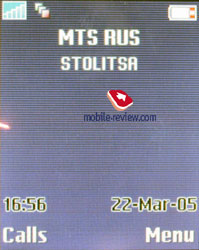
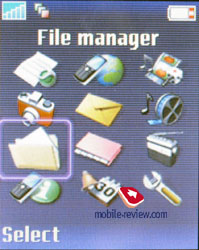
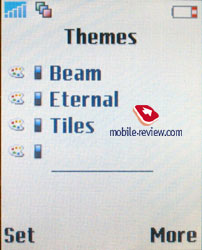

Radio. The phone has a built-in FM tuner; it
is different from other versions in RDS support that is a creeping
line with information transmitted by the radio station, a copy
of the same function in car radio player. The phone's memory can
store up to 20 radio stations; the stereo headset that is shipped
in every package plays the role of antenna. In case you are using
auto-search the phone will find about 6-7 stations with the strongest
signal's coverage (at least it did it in Moscow) and store them
in the memory. At the same time radio stations with weaker signal,
but pretty suitable for listening will be skipped. They can be
added into the list manually. This parameter is identical to Nokia
phones, in which same problems are noticed.
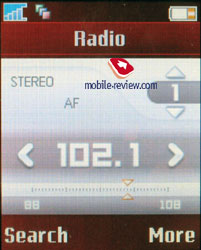
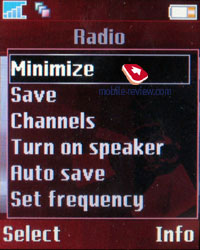
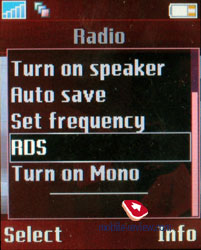

Signal's playback quality is rather high, the headset allows
setting up almost any volume, maximal level is extremely loud,
and the music will suppress everything. The user can switch the
radio into the loudspeaker mode; in this case people around will
hear it as well. The radio's volume is pretty high.
Unfortunately, all control is made from the phone's keyboard.
Channel switch which are stored in the memory - joystick's vertical
movement. You can regulate the volume with the help of side-buttons.
In case you want to turn off the radio and move on to other menu
item's functions you will have to minimize it the way you are
doing it on your desktop PC. In order to have the ability of changing
channels again you will have to call Radio mode again. In minimized
condition appropriate icon will appear.
Brief impressions from the radio can be described as positive,
this phone's parameter is interesting, more than that, it offers
quality realization. The radio is not worse than in Nokia's products
and this speaks out for a lot of things, as well as the fact that
the radio works in stereo mode.
File manager, memory capacity. The user can have about 30 Mb
of free space (and if erasing everything, it will form about 41
MB), on which his data, files (pictures, video clips, and applications)
can be stored. Remaining memory is occupied with pre-installed
applications, which you cannot delete. Part of phone's memory
is used as phonebook, call list etc.

The phone also gained simple file manager, with its help you
can sort files into various folders, create directories in the
phone's memory and store files in them. Using internal memory
for file storage is impossible; the phone declined storing files
with unknown extensions. But if you rename the file (its extension)
it will be easily stored in the phone's memory. Meanwhile when
we tried to view it, it lead to error; however the phone did not
freeze and continued working. In future you will be able to send
files via IrDA and Bluetooth in near future. Basically we face
the fact that the phone can be used as file storage for very important
files.

Player. The phone has built-in mp3 file player,
as well as 3GP, mpeg4. The player is actually a nice tool for
listening to mp3 files. Equalizer setup is present among the other
settings (Bass, Voice, Tremble etc), as well as the ability of
creating your own settings. Depending on these settings the sound
will actually change, this is noticeable. The presence of a memory
card turns the K750 into a fully-functional mp3 player with good
quality.
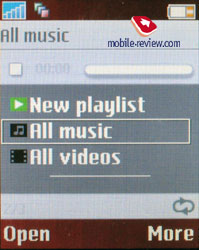
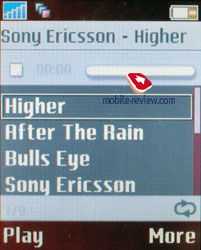
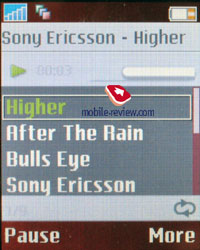
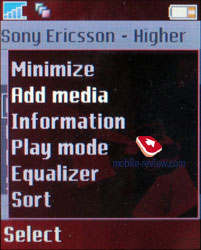
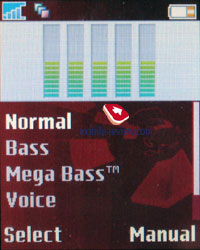

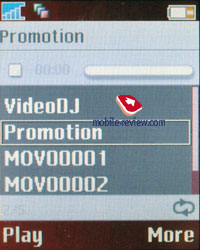
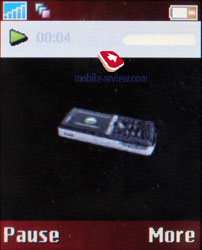
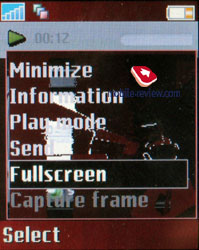



Camera. The device is equipped with a 2 MP camera with a CMOS matrix. This phone is the first widely spread one to have a 2MP camera if not considering Sharp 902. Another peculiarity of the model is the presence of an autofocus. It works for any distance including the Macromode.
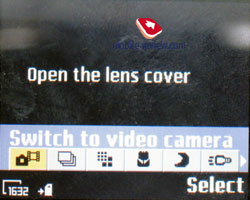
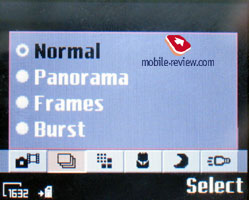
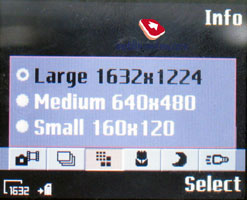
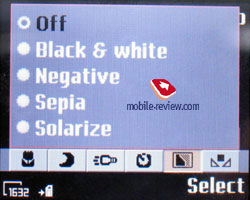
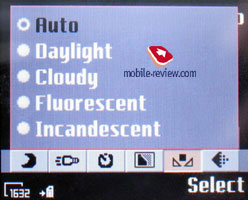
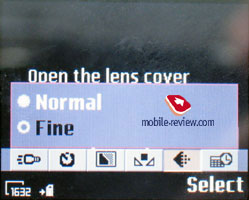
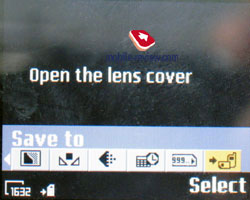
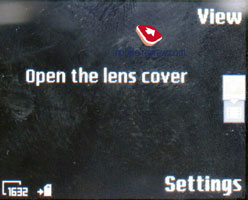
The device supports three possible resolutions - 1632x1224, 640x480, 160x120 pixels. Two types of data compression, Normal and Fine, are at your disposal. The majority of the photos represented are in the Normal quality, and they look quite well. The photos differ in size almost two times depending on the resolution. Thus a photo in the Normal mode takes about 300 KB when the Fine quality gives 500-600 KB. Saving the photo takes the same time not depending on the case, that is about 1-2 seconds, and that is quite well for such a file size. It feels like saving goes in a background mode, and a user can take more photos. If to take several photos one after another (not a Burst mode but just successively) then you'll notice slightly slowing writing speed (to 3-4 seconds). According to subjective feelings the device buffer is expected for 2 MB of memory.
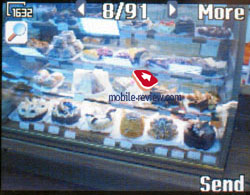
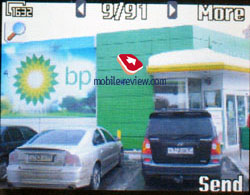
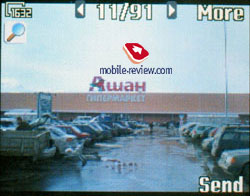
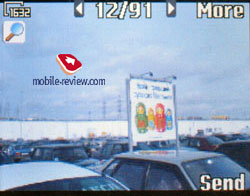
The camera settings look the following way:
Automatic camera off. When not used the camera turns off automatically in 30 seconds, 1, 2 or 3 minutes.
Shutter sound. You can choose on of the three shutter sounds but not turn the sound off.
Spot photometry. The function is unusual for a mobile phone.
White balance. A possibility to choose between an automatic mode or Incandescent, Fluorescent, Daylight, Cloudy.
Light. Backlighting activation, also may be turned on by shifting a left-side cover.
Effects. Several effects may be applied to the photos, they are Negative, Solarize, Sepia, Black & White.
Timer is activated for a certain time period for self shooting.
Night mode is for shooting in the dark. Noises raise on a photo, exposition is increased (you shouldn't move the device in order not to get a blurry photo).
Shooting mode. Normal mode, that is taking usual photos. A multiple mode (Burst 4) allows taking four photos for a series. Landscape is a very interesting mode that allows taking rather unordinary photos, has no rivals for the moment. The last mode is taking photos with frames, photo resolution decreases automatically.
Macromode allows turning the mode automatically.
The screen may serve as a viewfinder when in the shooting mode. The picture moves very smoothly and everything is clearly seen. Number keys help in switching between various functions and shooting parameters quickly that fastens work greatly.
Autofocus works well in the majority of cases and yields only to fast moving objects, for instance, cars. The picture often comes merged then. At the same time, a running man is always well seen, the picture is clear.
Processing a photo after shooting is a peculiarity of the phone. Before shooting you see a very sharp picture on the screen and half-pressed shutter button calls focusing like in usual cameras. When pressing it you take a photo and that is when the picture looses its sharpness. The explanation is the phone's processing algorithm; it spends no time to draw a picture on the screen and makes a rough sketch that takes less time. If entering a folder with photos and show a single photo on the screen you'll see it is sharp and the picture is quite saturated.
Let's acquaint with the photos taken in various conditions. We have chosen Samsung P750 equipped with a 2MP camera with a CCD matrix (all the pictures taken with the device are of the maximum resolution and quality). I'd like to say in advance, the Sony Ericsson product proved better though having a CMOS matrix. Let's start with the photos taken in the street.
Sample
photo outdoors, tube poster, 1632õ1224, Normal, 258 KB, JPEG
The same place with the objective of Samsung P750 - 336 KB, JPEG
Sample
photo outdoors, trolley bus stop, 1632õ1224, Normal, 313
KB, JPEG
The same place with the objective of Samsung P750 - 405 KB, JPEG
Sample
photo outdoors, Mayerhold center, 1632õ1224, Normal, 291 KB,
JPEG
The same place with the objective of Samsung P750 - 418 KB, JPEG
Sample
photo outdoors, lights and a sign, 1632õ1224, Normal, 207 KB, JPEG
The same place with the objective of Samsung P750 - 316 KB, JPEG
Sample
photo outdoors, Russian Post, 1632õ1224, Normal, 195 KB, JPEG
The same place with the objective of Samsung P750 - 257 KB, JPEG
Sample
photo outdoors, winter and aztecks, 1632õ1224, Normal, 318 KB, JPEG
The same place with the objective of Samsung P750 - 474 KB, JPEG
Sample
photo outdoors, yellow taxi, 1632õ1224, Normal, 230 KB, JPEG
The same place with the objective of Samsung P750 - 384 KB, JPEG
Sample
photo outdoors, house corner, 1632õ1224, Normal, 242 KB, JPEG
The same place with the objective of Samsung P750 -291 KB, JPEG
Sample
photo outdoors, Chaihana, 1632õ1224, Normal, 304 KB, JPEG
The same place with the objective of Samsung P750 - 361 KB, JPEG
Sample
photo outdoors, shop poster, 1632õ1224, Normal, 196 KB,
JPEG
The same place with the objective of Samsung P750 - 267 KB, JPEG
Sample
photo outdoors, Octyaborskaya metro station, 1632õ1224, Normal,
200 KB, JPEG
The same place with the objective of Samsung P750 - 325 KB, JPEG
Sample
photo outdoors, payment acceptance, 1632õ1224, Normal,
294 KB, JPEG
The same place with the objective of Samsung P750 - 381 KB, JPEG
Sample
photo outdoors, Magazine stand, 1632õ1224, Normal, 297 KB,
JPEG
The same place with the objective of Samsung P750 - 324 KB, JPEG
Sample
photo outdoors, ad on a tent, 1632õ1224, Normal, 251
KB, JPEG
The same place with the objective of Samsung P750 - 359 KB, JPEG
Sample
photo outdoors, Supersight Beeline on a house, 1632õ1224, Normal,
209 KB, JPEG
The same place with the objective of Samsung P750 - 350 KB, JPEG
Sample
photo outdoors, ash can, 1632õ1224, Normal, 294 KB, JPEG
The same place with the objective of Samsung P750 - 397 KB, JPEG
Sample
photo outdoors, snow alley, 1632õ1224, Normal, 360 KB,
JPEG
The same place with the objective of Samsung P750 - 473 KB, JPEG
Sample
photo outdoors, shop window, 1632õ1224, Normal,
299 KB, JPEG
The same place with the objective of Samsung P750 - 419 KB, JPEG
Sample
photo outdoors, traffic sign, 1632õ1224, Normal, 235 KB, JPEG
The same place with the objective of Samsung P750 - 327 KB, JPEG
Sample
photo outdoors, fence, 1632õ1224, Normal, 286 KB, JPEG
The same place with the objective of Samsung P750 - 342 KB, JPEG
You need only to compare several photos to notice the Sony Ericsson K750's quality is higher. Comparing the phone with any model in the market we can surely call it the best since it has the highest picture quality than all the others. It was interesting to compare the quality of indoors photos since there are problems with the light.
Here is an indoors photo, Leffe beer, 1632õ1224,
Normal, 522 KB, JPEG
The
same glass with the objective of Samsung P750 - 296 KB, JPEG
That's easy to see, Samsung gives way again. Later on we'd like to only represent the photos but not compare the quality.
Sample
photo indoors, tags and an ash tray, 1632õ1224, Normal,
568 KB, JPEG
Sample
photo indoors, tag, 1632õ1224, Normal, 551 KB, JPEG
Sample
photo indoors, candle, 1632õ1224, Normal, 417 KB, JPEG
Sample
photo indoors, window at the BP petrol station, 1632õ1224, Normal,
380 KB, JPEG
Sample
photo indoors, tags and an ash tray, 1632õ1224, Normal,
536 KB, JPEG
Sample
photo indoors, books on the shelf, 1632õ1224, Normal, 361 KB,
JPEG
Sample
photo indoors, Pampers on the shelf, 1632õ1224, Normal, 259
KB, JPEG
Sample
photo indoors, goods, 1632õ1224, Normal, 343 KB, JPEG
Sample
photo indoors, trade hall, 1632õ1224, Normal, 317 KB,
JPEG
Sample
photo indoors, clothes, 1632õ1224, Normal, 514 KB, JPEG
Sample
photo indoors, clothes hall, 1632õ1224, Normal, 583 KB,
JPEG
The lighting under the tube staircase, where there is poor light, could have been crucial; however the device endured this test also. It seems unnecessary to activate night mode in this device.
Sample
photo in a tube, window, 1632õ1224, Normal, 366 KB, JPEG
The same
thing by Samsung P750 - 394 KB, JPEG
Sample
photo in a tube, window, 1632õ1224, Normal, 335 KB, JPEG
The same
thing by Samsung P750 - 270 KB, JPEG
Night photos looked quite acceptable and are sharp in the majority of cases. The best photos are taken when there is a bright light spot, in the even lighting, long distance between the camera and the shoot object causes noises, which is quite typical.
Sample
photo at night, Moscow store, 1632õ1224, Normal, 520 KB, JPEG
Sample
photo at night, payment acceptance, 1632õ1224, Normal, 394
KB, JPEG
Sample
photo at night, operators' poster, 1632õ1224, Normal, 360 KB,
JPEG
Sample
photo at night, clock, 1632õ1224, Normal, 496 KB, JPEG
Sample
photo at night, Svyaznoy ad, 1632õ1224, Normal, 530 KB, JPEG
No lights in the elevator and here is when the flash saves.
Sample
photo in an elevator, without a flash, 1632õ1224, Normal, 558 KB, JPEG
Sample
photo in an elevator, with a flash, 1632õ1224, Normal, 465 KB, JPEG
Sample
photo with a flash – elevator button, 1632õ1224, Normal, 558 KB,
JPEG
You can convince the photos taken in the darkness are not less qualitative than in the daylight.
Sample
photo in the dark, shoe shop, 1632õ1224, Normal, 475 KB,
JPEG
Sample
photo in the dark, traffic lights, 1632õ1224, Normal, 362 KB, JPEG
Sample
photo in the dark, traffic lights in another angle, 1632õ1224, Normal,
286 KB, JPEG
Sample
photo in the dark, a boy with his mama, 1632õ1224, Normal, 439 KB,
JPEG
Sample
photo in the dark, a guitar by Beeline, 1632õ1224, Normal, 396
KB, JPEG
Sample
photo in the dark, pub entrance, 1632õ1224, Normal, 496 KB,
JPEG
Also we have taken many photos in various weather conditions and will represent only the most typical ones.
Sample
photo outdoors, Mega poster, 1632õ1224, Normal, 173 KB, JPEG
Sample
photo outdoors, poster about car evacuation, 1632õ1224, Normal,
247 KB, JPEG
Sample
photo outdoors, Ashan, 1632õ1224, Normal, 187 KB, JPEG
Sample
photo outdoors, Coca-Cola, 1632õ1224, Normal, 198 KB,
JPEG
Sample
photo outdoors, BP petrol station, 1632õ1224, Normal, 385 KB, JPEG
Sample
photo outdoors, Sberbank window, 1632õ1224, Normal, 408 KB,
JPEG
Sample
photo outdoors, advertisment, 1632õ1224, Normal, 375 KB, JPEG
Only macromode and working in it remained unconsidered. You just need to set the Macro function in the menu and the device starts shooting objects in the distance of several centimeters. No cavils appear and this mode works well. You only should not forget to turn it off, since latter photos might be not as sharp.
Sample
macromode photo, a tray holder with a note Ashan, 1632õ1224, Normal,
418 KB, JPEG
Sample
macromode photo, Kellog’s package, 1632õ1224, Normal, 493 KB, JPEG
Sample
macromode photo, Tkemali souse, 1632õ1224, Normal, 495 KB, JPEG
Sample
macromode photo, Tkemali souse, 1632õ1224, Normal, 486 KB, JPEG
Sample
macromode photo, MoneyGram, 1632õ1224, Normal, 196 KB, JPEG
Sample
macromode photo, ATM addresses, 1632õ1224, Normal, 217 KB, JPEG
Sample
macromode photo, graphic, 1632õ1224, Normal, 141 KB, JPEG
Sample
macromode photo, text on a graphic, 1632õ1224, Normal, 194 KB, JPEG
There is a 4x digital zoom in the phone. Using it seems not well-taken since the picture gets worse. Sample
zoom work in a file – 2.99 MB, ZIP>>>
See effects on another sample within an archive, ZIP, 2.33 MB >>>
There are quite various frames known by other models. In principle, a frame may be applied in a graphical editor and the same function in the shooting mode is for lazy ones. One may reveal his creative skills using a panoramic mode.
Sample
landscape ¹1, JPEG, 1664x432 pixels, 134 KB
Sample
landscape ¹2 JPEG, 1664x432 pixels, 145 KB
Sample
landscape ¹3 JPEG, 1664x432 pixels, 44.5 KB
I'd like to represent some photos with the maximum resolution and quality for the end.
Casio, 1632õ1224, Fine, 482 KB, JPEG
Market hall, 1632õ1224, Fine, 521 KB, JPEG
Video may be recorded in two resolutions (176x144, 128x96), file format is 3GP. Clip duration may be limited (up to 10 seconds) or unlimited. The quality of the clips is average and E720/E730, for instance, make more qualitative records, the same may be told about Sagem myX-8.
Sample
video (3GP, 627 KB)
Sample
video (3GP, 438 KB)
Sample
video (3GP, 698 KB)
You can't scroll video when watching it and the realization is subjectively average.
The conclusion is quite plain; the camera is the best in the market for today and the future 7-8 months. The device has no rivals in the picture quality. Moreover it is close to the ideal one considering the dimensions.
Java. The phone supports Java (MIDP 2.0), as
well as 3D-engine, which allows launching truly three-dimensional
games (not only Mascot Capsule is supported but JSR-184 also).
Some games already known by other models of the company are preinstalled.

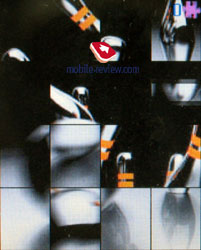
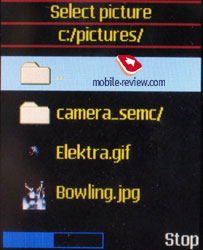

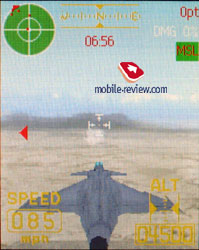
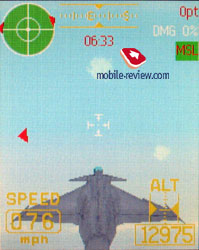
Productivity. We used JBenchmark to measure
the device's productivity, and its supporting 3D Java allowed
launching a corresponding test.
It gave the following results:
JBenchmark 3D
HQ 75
LQ 129
Triangles ps 17583
KTexels ps 819
3.0.2 version
176x220
M3G Version 1.0
Antialiasing false
True color false
Dithering false
Mipmapping true
Perspective correction true
Local camera lighting false
Max lights 8
Max viewport dimensions 1024
Max texture dimensions 256
Max Sprite Crop Dimensions 1024
Max Transforms Per Vertex 3
Number of Texture Units 2
Other properties
Color Screen true
Number of colors 65536
Transparency (alpha level) 256
Double buffer true
Total memory 524284
Free memory 436256
Comparing the results with Sony Ericsson Z800, K600 we see the
K750 a bit loosing. Tests of the renewed version of the software
showed the results are similar; the HQ parameter grew up to 92
points. As for me, the resulting operating speed will be comparable
with Sony Ericsson K600, no any great increase.
This rather low score is caused by a relatively "row"
3D Java in the model, the company integrated the standard to compete
with other manufacturers. The main emphasis of the model is put
on Mascot Capsule Engine providing high operating speed and being
less resource demanding. Unfortunately, we failed in finding games
for 3D Java similar to the preinstalled ones, but subjectively,
Mascot Capsule's productivity is much higher.
The second version of the test package gave the
following results:
|
K750i |
K600 |
| Jbenchmark 2 |
321 |
255 |
Details |
| Image manipulation |
194 |
175 |
| Text |
611 |
679 |
| Sprites |
295 |
261 |
| 3d Transform |
336 |
224 |
| User Interface |
289 |
153 |
2.0.4
176x176 True 65536 |
The results of the previous devices were high, and here it is
almost the maximum of all the phones on the market. The model
looses only to Linux solutions and some smartphones. Just to compare,
Nokia 6630 showed the score of 246 points and that is much less.
The first version of the package showed also the
productivity growth as compared with the previous models, including
the K600:
|
K750i |
K600 |
| JBenchmark 1 |
3845 |
2342 |
Details |
| Text |
1000 |
641 |
| 2D Shapes |
951 |
577 |
| 3D Shapes |
650 |
365 |
| Fill Rate |
377 |
279 |
| Animation |
867 |
480 |
1.0.4 |
The productivity is also very high and close to the maximum.
Indeed, as for the Java virtual machine speed the phone is one
of the strongest in its class, even comparable with smartphones.
Impressions
The 40-tones polyphony provides with a sound of the Sony Ericsson
K700 level or even lower, that also concerns preinstalled midi
melodies. The loudspeaker volume has no reserve when on the maximum.
It is frequently missed if using not mp3 melody as a call signal.
The loudspeaker volume is a weakness of the phone, you should
listen to it before buying to determine whether it is enough for
you or not. The power of a vibrating alert is average, no peculiarities.
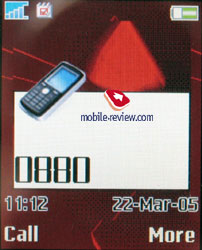
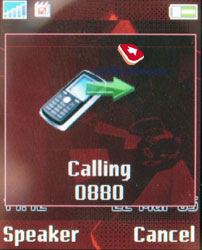

A photo of the caller and the number alternated with the name
or a number type icon are shown at the incoming call.
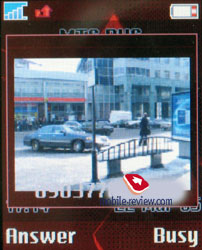
This company leader is more then an interesting offer by Sony Ericsson, but also the strongest model in this class on the market. At least for half a year this model will dominate on the market, other manufacturers will have to attain to its level, determine their price policy from the fact of the Sony Ericsson K750i's existence. Samsung D600 and Nokia 6230i are the main rivals, or more precisely, the models compared with the K750 even today. As for Samsung's product, the functionality is comparable, but the point is another form-factor. In general, they may be put on the same level, since the models are much alike, though Samsung looses in camera possibilities. Nokia 6230i belongs to a lower class with a worse screen, camera and mp3 player. In general the device is evidently intended for another market segment, and only EDGE may be mentioned of possible advantages. The delay of Nokia 6230i's launch won't allow the model to prevail over the Sony Ericsson solution; they should be expected on the market at the same time.
Small body size, a complete set of entertainment possibilities (radio, mp3, 3D Java) and good interface should be mentioned as the K750i's strengths. The model will certainly become a bestseller like Sony Ericsson's T610. Other manufacturers won't manage to integrate a functionally similar camera into a small device in a comparable time period. Nokia propagates using smartphone base for camera implementation, and that prevents them from creating a device of the Sony Ericsson K750i's level today. Nokia's copy of the device may be launched in the end of the year, but it will provide the same functionality for a higher price. In general there is no phone alternative to the Sony Ericsson K750i in a class of functional compact devices today. The model is of maximum saturated functionally; only smartphones may compete with it. Reasoning form the different form-factors of these devices, we can't speak about a straight competitor. Every user can choose a phone to their liking and, above all, to their hand. But similar cameras will remain a rarity even in smartphones till the end of the year.
The appearance of the model is expected at the end of May; primary saturation will come only in the middle of August, and the price will fall then. The first price may form about 500 Euro reasoning from the absence of rivals and high interest to the new device. The price reserve is the maximum today, if the company wanted to, it could offer the device for only 290 Euro in retail networks, but there is no necessity. The price correction is also caused by the appearance of a musical version of the K750 under the brand of Walkman called the W800 in September. The differences concern design, integration (the W800 has a 512 MB card in a kit, software for fast writing of CDs to a card), and the possibility to work with a radio block off (mp3 player mode). The price of W800 will form about 650-700 Euro for the launch moment. This is a good offer for a certain user group, and the device is not positioned for the masses. At the same time, the K750 has the maximum life circle and will be interesting for a long time (at least for 2 years).
Possible shortcomings of commercial examples
There is no commercial software for the model at the moment.
There are some mistakes in preliminary versions. We’d like to
describe them in a separate paragraph, the majority are to be
corrected by the start of the sales.
When assigning a photo to a contact in the phone book, you should remember the device doesn't transform the file into a smaller one. That was not relevant for low-resolution cameras but here a photo may take about 500-600 KB. And correspondingly, an empty window is shown at the call, since the photo has no time to upload completely and is shown jerkily. You also won't be able to scroll a list when editing the entry with a large photo, since showing and loading the picture is slow. The remedy is simple - use the lowest possible resolution when shooting portraits for the phone book or edit them on PC.
When working in camera mode (viewfinder shows the surroundings), the incoming call shows artifacts and lines appear. Screen orientation changes though the name and the number of a caller are displayed. The mistake will evidently be corrected by the beginning of the sales.
Shutter works incorrectly sometimes. Opening the shutter in the standby mode leads to switching from the screen saver mode but not to activating the camera. Only the second opening activates the camera.
In general, the software is stable and rouses no problems, even today with only a month and a half until the start of sales. The model is well balanced. It has no serious disadvantages in software that would be noticeable when using the device for long.
What next?
In the very beginning of the review we reminded of the pair models T68/T68i, T610/T630. A paired device for Sony Ericsson K750 was announced at the beginning and that is the W800. But it won't be the end of the development, and the model will be equipped the only absent function - UMTS. At last, a fully functional voice recognition system not depending on the accent might be implemented in the device. Labels will become unnecessary; menu items will be called and switched fast. The launch time is unclear and everything will depend on the current K750's sales. Considering their popularity, the renewal may be expected not earlier than in the autumn 2006. The presence of a 3 MP camera or even a bit better is mentioned in the preliminary specs. But the emphasis will be put on some other original but still not announced functions. Thus, the K750 successor will be interesting and, above all, compact.
































































































































